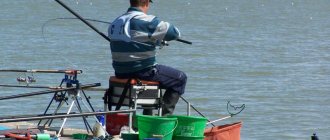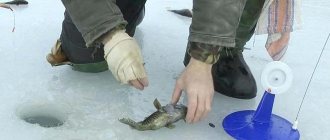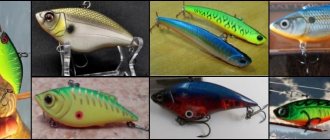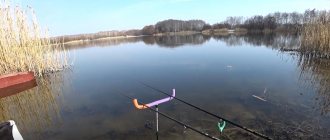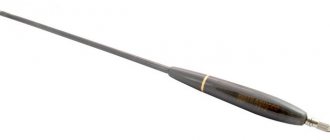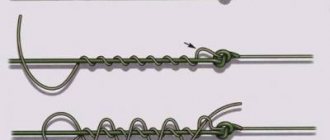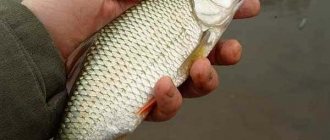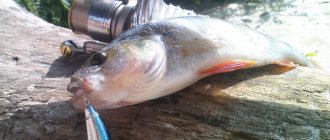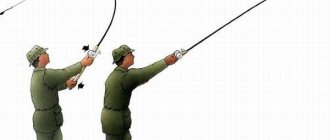At the same time, fishing with a float is fraught with some peculiarities. For example:
- When there is a current, the float is not located in one place.
- The float tilts and is not at a right angle.
- Since the float is in an unstable position, an illusory sensation of bites appears.
Floats
The float is considered one of the main elements of equipment. The success of fishing in the current depends on its design. Therefore, specially designed floats are available for such conditions. In order for the body of the float to create a minimum of resistance to the moving pressure of water, it is made wide, but flattened on both sides. As a rule, such floats have two attachment points. The extended part of the float acts as a control element. In order for the float to have a certain center of gravity, its design includes a metal rod, and a very thin one.
This design has minimal influence of the flow on the performance of the float. Most float designs for fishing in currents are designed in the shape of a “pear” or “egg”.
Since the floats have different shapes, they are intended for different fishing conditions:
- pear float is used when fishing at depth.
- egg float is used in conditions when the fish tries to take the bait away when biting, as well as for conditions when long casts are needed.
- A “ flat ” float is necessary when you need to keep the nozzle at the bottom in the presence of a current.
Sports floats
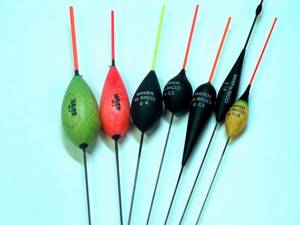
Every fisherman dreams of having in his arsenal a universal float designed for fishing in any conditions. Unfortunately, this dream will remain a dream, because this simply cannot happen. Although, there are floats that are very close to satisfying the needs of any angler. These include sports types of floats. Their operating principle is based on the fact that they are highly sensitive with a low center of gravity. These two factors make the sports float quite stable.
The design of such a float includes a float body, an upper ring with a cambric, an antenna and a keel. The float is attached to the main line using the top ring and the cambric, which is present on the keel.
If you adjust the position of the upper ring, you control the angle of inclination of the float. A float with such characteristics can easily be used in the current.
Flat floats
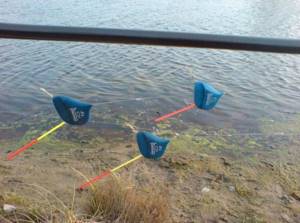
This is another type of float that has a narrow specialization. The body of the float has the shape of a flat disk, or another shape, but always flat. The highlight of a flat float is the keel, which is located at an angle. Thanks to this feature, the float is always in a vertical position.
The body of the float is always positioned with its edge facing the moving water, which minimizes its resistance.
Flat float Wing. Trial .
Feeding
Now let's talk about bait. Wiring fishing does not always become more effective when using bait. It is worth feeding a place only if you are fishing at a short distance. I won't give any exact numbers. If your float is in an area where you can throw bait fairly accurately with your hand without much effort, it’s worth feeding. In other cases, the bait will be washed away very quickly, and along with it, the fish will go downstream.
If you fish at a distance of complete control of the wiring, you can feed the place. Paradoxical as it may seem, you need to feed a little downstream of you. This is done so that when we reach the bait spot, our equipment takes on a working position, that is, the bait is on the spot and does not float in the water floor.
Loading the float when fishing in the current
For such gear, one lead sinker is not enough. In such conditions, the tackle often snags, so several sinkers will be required.
As a rule, fishermen give preference to 3 main types of float loading, depending on fishing conditions:
- When it is necessary to keep the bait at one point or carry out short-term retrieves. In this case, one load should be at the bottom of the river. Above it, at a distance of 3-5 cm, there should be two weights No. 3 and a weight that prevents the equipment from getting tangled. At a distance of 25 cm there is the main load, which has 90% of the total mass of the load.
- When postings are made with short-term stops. One load containing 10% of the total load should be at the bottom, and at a distance of 25-30 cm one pellet No. 5 is attached, and then, after 40-50 cm, a second pellet No. 5. After this, measuring 15-20 cm, the main load is attached, the value of which is 80% of the total load.
- When to catch bream. The float should have maximum stability, with reduced sensitivity. One pellet should be at the bottom. At a distance of 5 cm from this pellet, the remaining load is attached, which contains 90% of the total load. This loading technique does not allow for wiring, which every angler should remember.
Float Cralusso Bolo
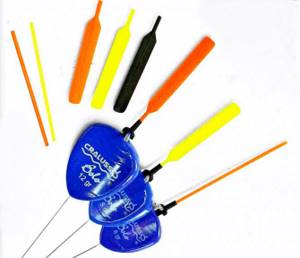
This float was invented by the Hungarian sports fisherman Károly Kralik. According to experienced fishermen, with the advent of such a float, fishing has acquired new interest. This float is used by both sports fishermen and amateur fishermen.
Thanks to this type of float, the Hungarian team won its victory at the World Fishing Championship in 2003. Having placed their main bet on the new Cralusso Bolo floats, the Hungarians were not mistaken. After this, many fishermen wanted to have the same floats.
The Cralusso Bolo float or “torpedo”, as it is also called, behaves steadily in the presence of any current. Floats can have a load from 0.5 to 40 grams.
It is applicable on rivers with different currents, as well as on canals. The most suitable technique for using a “torpedo” is to stop it at the point where the bait is located, as well as slow and stepped retrieves.
The float is equipped with a functional petal, which can be installed on the upper part of the float body. The presence of a petal allows you to guide the float even more steadily.
When the bait stops in the right place, there is no need to insert the tip of the float under the water: the petal will help make this much easier. The float is positioned on the line so that it does not come into contact with the body of the float.
Experts recommend the following equipment for a float weighing 30 grams: take a leash 40 cm long, then two pellets No. 4, and then three more pellets No. 3, 25 cm higher, and after 30 cm - the main load with a sliding sinker.
The Cralusso Bolo float, when compared with other types of floats, is easy to control and can be installed at any point without any problems.
Dependence of wiring on the type of coils
Casting using inertia-free models does not allow the bait to move freely with the current and without jerking. The fish do not like this behavior of the food. To fix the problem, you need to work with the rod - point its blank in the direction of the current, and wait until the stick follows the float in a smooth arc, release about 2 meters of line from the reel, and return the rod to its original position. True, even this does not always help to avoid torn wiring.
To learn more:
How many years does crucian carp live?
The use of inertial-type reels (often called “flying”) allows for more effective bait presentations without the use of a fishing rod. By holding the drum with your finger, it is much easier to adjust the delivery speed of the nozzle. The line will move without jerking, and the bait will not jump.
Such reels have proven themselves to work over long distances, allowing you to slow down the equipment by lightly holding the drum. And in places with strong currents, the brake can be set in such a way that the reel line will unwind on its own. The fisherman will only have to pause it at the right moment in order to carry out the hold.
DIY flat float
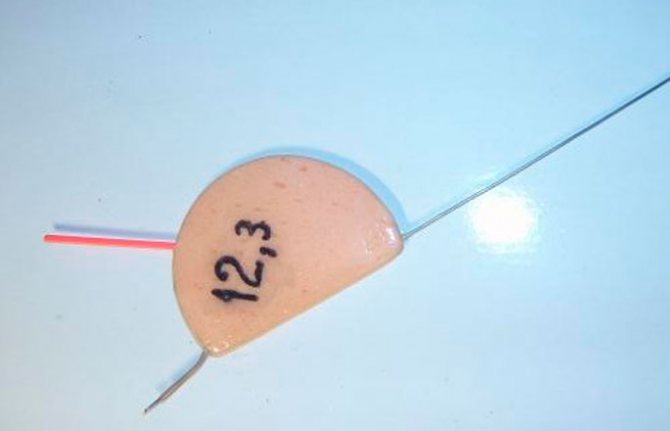
Experienced avid fishermen have stocked up on their own version of a flat float, such as (Bubble).
It’s not difficult to make yourself, and it works great on a fly or plug fishing rod. To manufacture it, you need to perform the following operations:
- To begin with, you need to find a suitable material, in the form of extracted polystyrene foam or balsa. Using a sharp tool, cut out a workpiece 7-13 mm thick.
- It is necessary to transfer a sample of the shape of the future float to the workpiece. You can get hold of a template if you turn to the Internet for help.
- Using a sharp knife, the shape of the future float is cut out. You can leave allowances of 2-3 mm.
- Taking fine sandpaper in hand, the body of the float is carefully processed.
- The keel is made of bamboo or a piece of wire with a diameter of 0.7-1 mm. The antenna is made in the same way.
- Using a sharp object, in the form of a knitting needle, it is necessary to make a depression on the body of the float, up to 2 cm in size. After this, the antenna is attached using glue. Perpendicular to the keel, a paper clip is attached to the body of the float as an additional attachment point.
- It makes no sense to paint the body of the float, since only the keel arrow will peek out of the water. As for the antenna, a bright color doesn't hurt. Alternatively, you can attach brightly colored heat shrink tubing to the keel.
Flat Float - Wing
Fishing in weak currents
For such fishing conditions, it is enough to load the float weighing from 4 to 8 grams. In this case, a leash 10 cm long is enough, which should be located at the bottom. Above the leash, every 10 cm, three small pellets are attached, which are needed to regulate the speed of lowering the bait to the bottom.
Massive pellets are located directly behind the leash. This type of rig allows the bait to sink slowly without spooking the fish. With such tackle you can catch ide, rudd, roach, etc.
Fishing in the middle reaches
For such conditions, select a float with a carrying capacity of 6 to 20 grams. A short leash will not be effective, so you need to take a piece of fishing line 60-150 cm long. Moreover, the main part of the leash should be at the bottom. The bulk of the pellets are located near the leash, and smaller pellets are attached every 10 cm.
The rod should be directed so that the leash with the hook and bait is carried forward by the current from the float. In this case, the float will not lie on the water, and the bait will sink to the bottom and will not have time to be carried away by the current.
FISHING with a FLOAT in a QUICK CURRENT
What is wiring?
The use of float gear (the so-called “Bolognese”) is a prerequisite for fishing from a boat or from the shore to please fans of such fishing with excellent results. The depth of the river should be sufficient for the bait on the hook to pass along the bottom, practically touching it.
The process is not complicated: after releasing the equipment into the water (while avoiding the fishing line getting caught on one of the rings), the reel is released and, placing the float on the current, it is sent into free swimming. The bait on the hook must be moved above the feeding areas.
There are three types of postings:
- the usual simplest technique (passive, with holding and catching with a wire);
- long-distance bait delivery technique;
- short-range wiring technique.
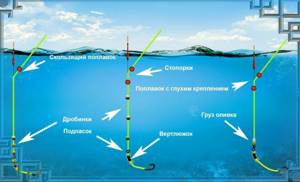
The simplest technique
In this way, the line is easily released from the reel, allowing it to move evenly with the current. This makes it easier for the nozzle to change its position and adapt to the movement of water. A technique that does not require much effort from the fisherman is called passive or free. It justifies itself in places where schools of bottom dwellers gather and when there is active biting.
However, anglers more often use the holding technique, slowing down the unwinding of the fishing line from the reel spool with their finger. In this case, the float stops, moving at a lower speed than the water, and the nozzle rises upward under the influence of the current. After some time, the line is released again, and the tackle moves on. Such movements of the food attract the attention of the fish and provoke them to swallow the bait.
In cases where the float, while being held, jumps out of the water column or rapidly approaches the coastal zone, the number of manipulations should be reduced.
The technique of fishing with a wire is that the weight and leash move along the bottom, and the bait moves in front under the influence of the current.
From time to time the angler must hold the tackle. The wiring will be effective if the depth is set correctly and the antenna on the float tilts with the current. The application of the technique proves its effectiveness in the case when a school of fish is in the middle layers.
To learn more:
How to choose a good reel for a fishing rod?
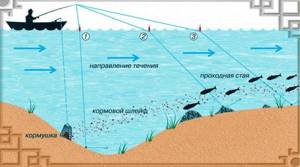
Far technique
The wisdom of this option is that the gear allows you to swim a distance of 20-30 meters. It should be noted that the initial casting distance should not exceed the length of the rod by more than twice. Long-distance fishing is preferred in water areas with strong currents and depths of no more than three meters, as well as in cases where a diligent fisherman has to fish hard-to-reach places, and casting is done in a strong tailwind.
In practice, this wiring is carried out according to the following scheme: the float is thrown to the required distance from the shore line, for some time it moves downstream to the original point of wiring. Then, by controlling the holding force of the floating float, it is forced to move along the desired trajectory.
In cases where the wind blows the float towards the fisherman, the tackle must be cast further away, and when he approaches the starting point of the retrieve, move it to the required distance with the help of a rod, controlling the strength and holding time.
Close wiring
This fishing technique is most common and is used in places with great depths and slow water movement. It depends on the influence of the wind (a vortex with the current interferes, but against it helps), and strong gusts do not allow the use of short-range guiding methods at all.
This type of bait delivery is carried out at distances ranging from 10 to 15 meters. It allows you to fish over long distances (maximum performance depends on the length of the rod used and the depths in the fishing areas). Such postings require close attention to ensure that the telescope or feeder stick is located towards the shore, and the angle between the float and the fishing line hanging from the tip of the rod relative to the angler’s location is close to 90°.
You need to get used to the process, since at first it will be difficult to keep the float on the desired trajectory. The success of fishing depends not only on the speed of the current, the number and frequency of holds, but also on the weight of the equipment. Weakly loaded tackle is harder to stop in time, but if you make it heavier, you will lose the sensitivity of bites.
Equipment for fishing in strong currents
In the presence of a rapid current, fishing becomes very difficult, since the bait is still carried away by the fast current and the fisherman has to control the position of the float with the equipment using a fishing line. As a rule, a float with a carrying capacity of up to 40 grams is selected. A leash of two meters length is required. At the same time, almost all of it should be located at the bottom. All weights must be moved directly to the leader so that the equipment sinks to the bottom very quickly.
Float for fishing in fast currents: Fishing with Normund #16
Fishing in the current with a sliding float
To mount the sliding version of the equipment you need:
- Attach the reel to the rod.
- The end of the fishing line is passed through all the rings and attached to the spool of the reel.
- You need to wind about 100 meters of fishing line on the reel, but no less.
- At the other end of the fishing line, measuring one meter, a rubber or silicone stopper is put on.
- After this, a sliding float is put on the fishing line.
- Then another stopper is placed at a distance of 0.7 m from the first one, and a set of weights for the flow is also attached.
- A loop is formed at the end of the fishing line for attaching the leash.
Gear setup: rod, reel, equipment
Effective line fishing is ensured by a clearly tuned fishing rod. The gear must combine all the elements.
We suggest you read: How to fish with a spinning rod
Rod
The rod for float fishing in the current plays a leading role. Since the fisherman practically never lets go of the fishing rod, the main requirement when choosing a “stick” will be the minimum weight. Carbon-fiber telescopic models equipped with guide rings and a reel seat are ideal for completing gear.
The length of the rod is selected taking into account the characteristics of fishing. For coastal fishing, long telescopes of 5...7 m are required. The longer the fishing rod, the faster the action should be. When fishing from a boat, models up to 4 m long are suitable. They can be either telescopic or plug-in type. In recent years, Bolognese fishing rods have become especially popular, meeting all the requirements of anglers.
Coil
What kind of reel should be used for line fishing? Experienced fishermen have two views on this element of gear. When fishing far from the shore, it is more convenient to cast with a spinning reel. Only the spool should be large, then there will be fewer rings on the line. To ensure that the fishing line always stretches into an even line during wiring, it is better to use high-quality drum-type models.
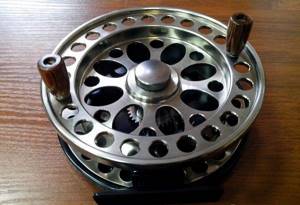
Photo 2. Assembly and operation of a fishing rod for line fishing
The choice of fishing line is determined by both the clarity of the water and the size of the intended prey. Typically, a monofilament thread with a diameter of up to 0.20 mm is wound onto a reel. The leash is made from a less strong fishing line, the thickness of which is 0.02 mm less than the base.
Recommendation! In autumn, in cold, clear water, it is better to use fluorocarbon for making a leader.
